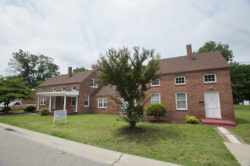
400 Years Forward: Black History Driving Tour in Hampton, VA
Celebrate Black History by taking a self-guided driving tour of Hampton, Virginia’s rich African American heritage sites. The 400 Years Forward driving tour explores the location of the first landing of Africans on American soil, where the first Southern reading of the Emancipation Proclamation happened, Virginia’s only known African American missionary chapel, and more. These African American heritage sites are a must for any black history interest.
Hampton History Museum
120 Old Hampton Ln, Hampton, VA 23669
757-727-1102

Begin your driving tour with a visit at Hampton History Museum. Learn about Hampton history and contributions of African Americans in Hampton. The 10 galleries are filled with the city’s history, as you travel from the 17th century to the present day.
The exhibits include the first African arrival in 1619, to the Hidden Figures exhibit showcasing the city’s involvement with the U.S. space program. Each gallery shares the important contributions of African Americans to Hampton history.
Fort Monroe National Monument
51 Fenwick Rd, Fort Monroe, VA 23651

After taking a trip through 400 years of history, travel to Fort Monroe, the largest stone fort in the United States.
At Fort Monroe begin your tour at the First Africans in Virginia historical marker. It was at this spot in 1619 that the first Africans in English North America landed at Old Point Comfort. These first Africans brought with them their languages, cultures, and traditions that along with their perseverance would forever change the course of the United States.
After visiting the First Africans Marker, take a self-guided walking or driving tour of Fort Monroe. You can pick up a printed copy of the walking tour at the Fort Monroe Visitor & Education Center, or follow along with our digital cell phone tour of Fort Monroe.
Fort Monroe illustrates the “Arc of Freedom.” 242 years after the First African Landing, in 1861, three enslaved men escaped to Fort Monroe and were accepted at the Fort as “contraband of war,” and were not returned to their owners. Many more would follow them. While touring the Fort, visit the Fort entrance where contraband enslaved people from all over the area entered. Later nicknamed “Freedom Fortress”, Fort Monroe is filled with 21 unique sites featuring history, architecture, and nature for you to explore.
Emancipation Oak
100 E Queen St, Hampton, VA 23669

Next on your driving tour is the Emancipation Oak at Hampton University. A living symbol of freedom for African Americans, the first Southern reading of the Emancipation Proclamation was under this Oak in 1863.
Designated as one of the “10 Great Trees of the World” by the National Geographic Society, this oak is 98 feet in diameter, and continues to be a source of inspiration and freedom for all.
Little England Chapel
4100 Kecoughtan Road, Hampton, Va 23669

Next, drive to Little England Chapel. Built in 1879, this is Virginia’s only known African American missionary chapel. Exhibits interpret the religious lives of post-Civil War African Americans in Virginia and include handwritten Sunday school lessons, photographs, a 12-minute video, and 19th-century religious books.
Call ahead to tour this State and National Historic Landmark.
Recommended: Soulful Sanctuaries: Discovering the Rich Heritage of Black Churches in Hampton
Tucker Family Cemetery
1 Sharon Court, Hampton, VA 23666

Your next stop will take you to the Tucker Family Cemetery. One of the oldest black cemeteries in Hampton, it is the resting place for generations of the William Tucker Family.
William Tucker, the first recorded baby of African descent born to be baptized in English North America. He was the son of Anthony and Isabella who were among the first “twenty and odd” Africans to arrive at Point Comfort aboard the White Lion in 1619.
Aberdeen Gardens
55 and 57 N. Mary Peake Boulevard, Hampton, VA 23666

Finally, conclude your driving tour with a visit to Aberdeen Gardens. This historic neighborhood was built for “Blacks by Blacks” in 1935 as part of the New Deal Settlement. Out of the 55 New Deal communities proposed and constructed at the time, Aberdeen Gardens was the only Resettlement Administration community for Blacks in Virginia.
Listed on the Virginia Landmarks Register, this iconic neighborhood is also on the National Register of Historic Places. The museum is currently closed for renovations, however, there are historical markers in the backyard to learn more about the neighborhood’s heritage and original residents.
Recommended: Cell phone tour for Aberdeen Gardens
Want to learn more? The newly updated Family Tree is a guide to African American heritage, history, famous footsteps, landmarks and more:
During, after or before your driving tour, we invite you to visit Black-owned restaurants in Hampton. These restaurants offer culinary delights including fresh seafood, Southern cuisine and something for your sweet tooth.
